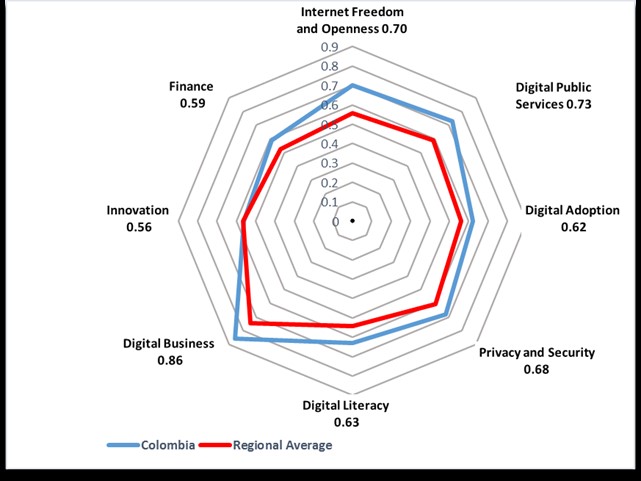 Eduardo Salido,
Eduardo Salido,
Colombians have many reasons to celebrate these days. It has been a long journey of conflict, spanning 52 years, but today Colombians are closer to a peace agreement than ever before. This is not the only piece of great news for the cafeteros. In a region where countries such as Brazil or Venezuela are struggling with a recession, the Colombian economy shows signs of soundness. Despite adverse global circumstances, Colombia’s successful policies and inclusive growth agenda promoted economic development in 2015 and will do so in 2016. During the last decade Colombia’s strong policy framework has underpinned high GDP growth. In 2015, the poverty rate declined to 24.1 % from 24.6 % in 2014[1]. Income inequality, as measured by the Gini coefficient[2], declined to 52.2. Colombia is also gaining momentum in the international political arena with its adhesion to the OECD “The rich countries club”. Last but not least, Colombia appears as one of the top performing countries in the recently launched Telefonica Index on Digital Life (TIDL).

On August 31 Telefónica launched the results of TIDL at ANDICOM, the digital industry event in Cartagena de Indias, which gathers together 2500+ professionals, tech experts, entrepreneurs and policy makers. Carlos López Blanco, Global Head of Public and Regulatory Affairs presented the Colombian results of the Index. The first piece of good news comes early. Colombia is the second best performing economy across-the-board among the Latin American countries ranked in TIDL, right after Chile. Colombia is Latin America’s most outstanding over-performer in Digital Life relative to its GDP per capita. It beats GDP-predicted expectations in all domains of Digital Life, showing equal over-performance in each. However, this does not mean there is room for complacency, as Colombia only performs to Latin American average for innovation. On a positive note, Colombia government’s active role in promoting mobile and e-money and financial inclusion should contribute to continued improvement in Digital Life.
The set of indicators shown in the TIDL come to Colombia in a moment when the National Commission of Regulation in Colombia seeks to define the key performance indicators for the Digital Economy.

Let’s look the ins and outs of Colombia’s digital life.
Digital Openness
Digital Openness means how easily citizens and businesses can harness the digital infrastructure that exists in the country. An open Internet is universally accessible, can be globally reached, is interoperable and allows open innovation without the need to obtain permission. It enables portability of citizen’s digital life (apps, content, etc.) between platforms and it is an environment in which people can publish and access the content, services and applications of their choice, facing no restrictions to switch between them.
Colombia ranks first (relative to per capital GDP) in Digital Openness among its Latin American peers. According to Freedom on the Net 2015 report (annually published by Freedom House think tank) Colombia is a partially free country in Internet. As highlighted in the publication the Internet increasingly plays a central role in social movements in Colombia. A study from the NGO Somos Defensores (“We Are Defenders”) indicates that during the first decade of the 21st century, Colombian social movements used the Internet primarily to display official information, but within the last five years, as the popularity of the internet has grown, these movements have embraced the online environment to campaign and investigate issues of interest to their members.
Digital Confidence
Colombia ranks sixth among its Latin American peers when it comes to Digital Confidence – this is the readiness with which citizens and businesses engage with a country’s digital infrastructure, enabled by the level of Internet privacy and security. This is one of the most obvious bottlenecks for Colombia’s digital development. One of the measurements used to rank each country’s digital confidence is Internet adoption, defined by six different variables: Internet domain names, home and individual Internet penetration, mobile Internet penetration, smartphone and Internet use. There are different factors behind the poor performance of Colombia in this field:
The digital divide: The difference in access to the Internet between different social groups in a given economy or society.
The affordability of mobile devices.
But there is also good news in the digital confidence arena for Colombia. Colombia ranks top when analysing privacy and security issues. There might be some good policy choices behind this fact. In 2011 Colombia drafted a document that highlights the need to adopt a cybersecurity and cyberdefense strategy for the country. In 2015 this document was updated (with the recommendations of the Organization of American States) highlighting the need for further cooperation between public and private sector and involving the academia. Cybercrime is one of today’s threats to business, citizens and governments, so the appropriate strategy is very welcome.
Digital Entrepreneurship
Last but not least, digital entrepreneurship (this is the ability of the economy to embrace Digital Life by leveraging its digital infrastructure for innovation, entrepreneurship and economic growth) in Colombia is a source of hope. Colombia ranks third relative to per capital GDP. This reveals the entrepreneurial spirit of Colombians as well as the efforts carried out by public institutions in recent years. As Luis Alberto Moreno, President of the Inter-American development Bank stated in the Financial Times: “The Colombian plan, Vive Digital, fosters internet adoption among all its citizens. Taxes on computers, tablets and smartphones have been scrapped. Low-income families have been given vouchers to sign up for broadband”. And entrepreneurs also benefitted from Vive Digital. MiPyme, one of the tools of Vive Digital, increases the access and use of Internet among small and medium Colombian enterprises, so they can boost their productivity and compete at a global level.
Despite all these efforts, there is room to improve digital life in Colombia. The Government should conceive the Digital Economy as a national priority and a national policy objective. A country with such a young population should put the effort and focus on digital attitudes (privacy, security, digital threats and opportunities), digital skills (human capital, digital education, etc.) and digital aspirations such as digital business, innovation, digitally-driven business internationalization and availability of venture capital and other sort of funding for digital business. These are happy days for Colombia and its citizens should celebrate but there is still a long road to achieve the digital excellence.
[1] IMF Article IV Colombia 2016
[2] The Gini coefficient (sometimes expressed as a Gini ratio or a normalized Gini index) is a measure of statistical dispersion intended to represent the income distribution of a nation’s residents, and is the most commonly used measure of inequality.








